| Poecile | |
|---|---|
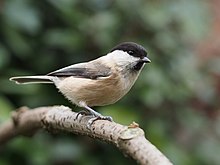
| |
| Willow tit, Poecile montanus | |
| Scientific classification | |
| Domain: | Eukaryota |
| Kingdom: | Animalia |
| Phylum: | Chordata |
| Class: | Aves |
| Order: | Passeriformes |
| Family: | Paridae |
| Genus: | Poecile Kaup, 1829 |
| Type species | |
| Parus palustris Linnaeus, 1758
| |
| Species | |
|
see text | |
Poecile is a genus of birds in the tit family Paridae. It contains 15 species, which are scattered across North America, Europe and Asia; the North American species are the chickadees. In the past, most authorities retained Poecile as a subgenus within the genus Parus, but treatment as a distinct genus, initiated by the American Ornithologists Union, is now widely accepted.[1] This is supported by mtDNA cytochrome b sequence analysis.[2]
The genus Poecile was erected by the German naturalist Johann Jakob Kaup in 1829.[3] The type species was subsequently designated as the marsh tit (Poecile palustris) by English zoologist George Robert Gray in 1842.[4][5] The name Poecile is from Ancient Greek poikilos "colourful". A related word poikilidos denoted an unidentified small bird.[6] It has traditionally been treated as feminine (giving name endings such as cincta); however, this was not specified by the original genus author Johann Jakob Kaup, and under the ICZN the genus name must therefore be treated by default as masculine, giving name endings such as cinctus.[1]
| ||||||||||||||||||||||||||||||||||||||||||||||||||||||||||||||||||||||||||||||||||||||||||
| Phylogeny of the Poecile based on Tritsch et al. 2017.[7] |
Species
[edit]The genus includes the following fifteen species:[8]
| Image | Common Name | Scientific name | Distribution |
|---|---|---|---|
 |
White-browed tit | Poecile superciliosus | central China and Tibet. |
 |
Sombre tit | Poecile lugubris | southeast Europe and southwest Asia |
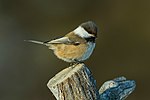 |
Grey-headed chickadee (North American name) or Siberian tit (European name) | Poecile cinctus | subarctic Scandinavia and northern Asia, and also into North America in Alaska and the far northwest of Canada |
 |
Chestnut-backed chickadee | Poecile rufescens | Pacific Northwest of the United States and western Canada, from southern Alaska to southwestern California |
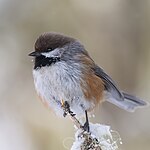 |
Boreal chickadee | Poecile hudsonicus | Canada, Alaska, and northernmost portions of the lower 48 United States |
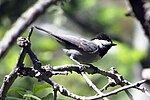 |
Mexican chickadee | Poecile sclateri | Mexico |
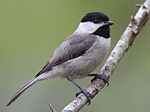 |
Carolina chickadee | Poecile carolinensis | United States from New Jersey west to southern Kansas and south to Florida and Texas |
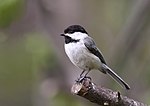 |
Black-capped chickadee | Poecile atricapillus | Across North America, from New England to Newfoundland in the east, and from Washington to Alaska in the west |
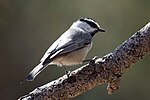 |
Mountain chickadee | Poecile gambeli | western United States |
| Père David's tit | Poecile davidi | central China in southern Gansu, western Hubei, southern Shaanxi and Sichuan | |
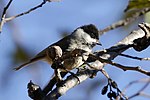 |
Black-bibbed tit | Poecile hypermelaenus | central and eastern China to southeast Tibet and western Myanmar. |
 |
Marsh tit | Poecile palustris | temperate Europe and northern Asia |
 |
Sichuan tit | Poecile weigoldicus | central China |
| Caspian tit | Poecile hyrcanus | northern Iran, just extending into Azerbaijan. | |
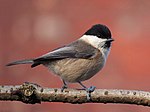 |
Willow tit | Poecile montanus | temperate and subarctic Europe and northern Asia |
References
[edit]- ^ a b Gosler, A.; Clement, P.; Bonan, A. (2019) [2007]. del Hoyo, J.; Elliott, A.; Sargatal, J.; Christie, D.A.; de Juana, E. (eds.). "Tits and Chickadees (Paridae)". Handbook of the Birds of the World Alive. Lynx Edicions. doi:10.2173/bow.parida1.01. S2CID 216446005. Retrieved 27 August 2019.
- ^ Gill, F.B.; Slikas, B.; Sheldon, F.H. (2005). "Phylogeny of titmice (Paridae): II. Species relationships based on sequences of the mitochondrial cytochrome-b gene". Auk. 122 (1): 121–143. doi:10.1642/0004-8038(2005)122[0121:POTPIS]2.0.CO;2.
- ^ Kaup, Johann Jakob (1829). Skizzirte Entwickelungs-Geschichte und natürliches System der europäischen Thierwelt (in German). Vol. c. 1. Darmstadt: Carl Wilhelm Leske. p. 114.
- ^ Gray (1842). Appendix to a List of the Genera of Birds (2nd ed.). London: R. and J.E. Taylor. p. 8.
- ^ Dickinson, E.C.; Christidis, L., eds. (2014). The Howard & Moore Complete Checklist of the Birds of the World. Vol. 2: Passerines (4th ed.). Eastbourne, UK: Aves Press. p. 428. ISBN 978-0-9568611-2-2.
- ^ Jobling, J.A. (2018). del Hoyo, J.; Elliott, A.; Sargatal, J.; Christie, D.A.; de Juana, E. (eds.). "Key to Scientific Names in Ornithology". Handbook of the Birds of the World Alive. Lynx Edicions. Retrieved 15 May 2018.
- ^ Tritsch, Christian; Martens, Jochen; Sun, Yue-Hua; Heim, Wieland; Strutzenberger, Patrick; Päckert, Martin (2017). "Improved sampling at the subspecies level solves a taxonomic dilemma – A case study of two enigmatic Chinese tit species (Aves, Passeriformes, Paridae, Poecile)". Molecular Phylogenetics and Evolution. 107: 538–550. Bibcode:2017MolPE.107..538T. doi:10.1016/j.ympev.2016.12.014. PMID 27965081.
- ^ Gill, Frank; Donsker, David (eds.). "Waxwings and their allies, tits & penduline tits". World Bird List Version 6.1. International Ornithologists' Union. Retrieved 15 February 2016.